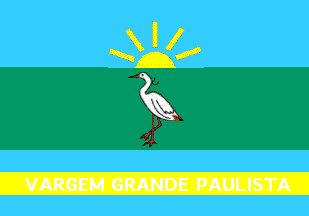 image by
Ivan Sache, 21 February 2013
image by
Ivan Sache, 21 February 2013 Based on: http://www.vargemgrandepta.sp.gov.br/site/?page_id=44

Last modified: 2013-03-16 by ian macdonald
Keywords: sao paulo | vargem grande paulista |
Links: FOTW homepage |
search |
disclaimer and copyright |
write us |
mirrors
 image by
Ivan Sache, 21 February 2013
image by
Ivan Sache, 21 February 2013
Based on:
http://www.vargemgrandepta.sp.gov.br/site/?page_id=44
A blue-green-blue horizontal triband, ratio 1-2-1, with a demi-sun in the upper band, a heron in the central band and the name in white in the lower band.
Official website at
http://www.vargemgrandepta.sp.gov.br
Dirk Schönberger,
21 February 2013
The flag of Vargem Grande Paulista is with dimensions 8 units x 11 units, compliant with the Brazilian legislation*, made of three horizontal stripes. The upper stripe is celeste blue with a six-rayed yellow rising sun. The central stripe is spring green, charged with a white heron in profile. The lower stripe is celeste blue with the writing "VARGEM GRANDE PAULISTA" in white letters outlined in black.
The flag is a banner of the municipal arms (crown, supporters and scroll excluded), designed by Nilton Alves Barbosa and prescribed by Municipal Law No. 21 of 12 September 1983. "A classical, Flemish-Iberian shield, surmounted by a six-towered mural crown [argent]. Vert a heron argent a chief azure a six-rayed rising sun or a base azure. The shield supported dexter by a pioneer holding a gun and sinister by a field worker, the two standing on a scroll vert inscribed with '1893 / VARZEM GRANDE PAULISTA / LIBERTADE, FÉ E TRABALHO / 1981' in letters argent." The motto is written under the municipality's name, in smaller letters.
http://www.vargemgrandepta.sp.gov.br/site/?page_id=44 - Municipal website
*This should rather be 7 units x 10 units, but the difference in proportions is quite small (0.73 vs. 0.7).
The flag used during a ceremony involving the Municipal Guard matches
the official description.
http://gcmvgp.blogspot.fr/2012/05/guarda-apoia-juramento-bandeira-com.html
The flag hoisted in the meeting room of the Town Hall, however, has
the writing placed on a yellow stripe not prescribed by the Law.
http://www.vargemgrandepta.sp.gov.br/site/wp-content/uploads/2013/01/Mesa-Diretora_Camara.jpg
http://www.vargemgrandepta.sp.gov.br/site/wp-content/uploads/2012/12/Sessao-Solene03.jpg - yellow stripe
The Flemish-Iberian shield, also known as Peninsular or Portuguese shield, one of the most used in the Iberian Peninsula, represents the colonizers and main builders of the Brazilian nation. The six-towered mural crown argent stands for a third-rank town, seat of a municipality. The celeste blue chief represents the healthy climate of the municipality, as well as justice, nobleness, perseverance, loyalty and zeal. The sun or alludes to gold, a resource that allowed the autonomy of the municipality. The black horizontal lines separating the fields represents the flat topography of the region. The green field represents the soil and the abundant arable fields of the municipality, as well as hope and liberty. The heron is a typical bird of the "vageado"**, recalling the etymology of the municipality's name. The celeste blue base, "ecologically" completing the shield, represents the lake, the limpid water and the several sources found in the municipality. The pioneer represents Raposo Tavares***, the namesake of the road that crosses the municipality. The field worker represents the first colonizers of the region, especially, the Japanese**** settlers who introduced modern agricultural techniques. The Latin motto reads "Liberty, Faith and Labour". The years are those of the onset of colonization (1893) and of municipal emancipation (1981).
http://www.vargemgrandepta.sp.gov.br/site/?page_id=44 - Municipal website
**"vargeado" must be a a local form of "várzea", a flooded land near a
river.
***António Raposo Tavares (1598-1658), the "legendary pioneer", led
his first expedition in 1628, which allowed the annexation of the
current States of Paraná and Santa Catarina to Portugal. He led a
second expedition in 1636, which allowed the annexation of the current
state of Rio Grande do Sul. His last and most famous expedition
trailed in 1648 from São Paulo to Belém. Out of the 1,200 members of
the expedition, only 60 reached Belém, including Tavares himself.
****Japanese colonization started in 1929. In 1994, the Japanese
established the "Cooperativa Agrícola de Cotia", today Coopervag
(Cooperativa Agrícola de Vargem Grande Paulista).
Ivan Sache, 23 February 2013
 image by
Ivan Sache, 21 February 2013
image by
Ivan Sache, 21 February 2013
The variant has the name in white on a yellow stripe.